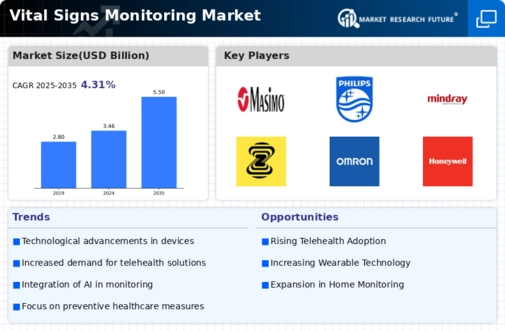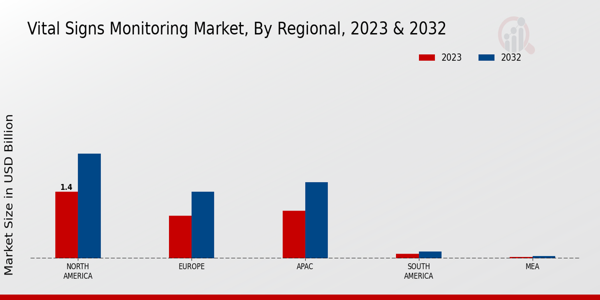Vital Signs Monitoring Size
Vital Signs Monitoring Market Growth Projections and Opportunities
Vital Signs Monitoring Market is anticipated to reach USD 7.44 billion by 2023 with a CAGR of 8.42% (during the forecast period). The market for vital signs monitoring is driven by myriad factors that define its growth and dynamics together. The increasing prevalence of chronic diseases and the rising focus on preventative healthcare are primary drivers for this market. More than ever before, the future of the vital signs monitoring market will be shaped by technological advancements. Continuous innovation in sensor technologies, wearable devices, connectivity solutions, etc., leads to the production of more accurate, user-friendly, and integrated vital signs monitoring systems. This includes but is not limited to real-time data transmission, remote-monitoring abilities, and analytics based on artificial intelligence, among others; these smart features facilitate vital sign monitoring in different healthcare capacities. The regulatory perspective is a crucial factor affecting the market dynamics of vital signs monitoring devices. Tight regulatory standards and approvals are required from manufacturers to ensure patient safety and device efficiency. Moreover, economic conditions such as healthcare spending levels and compensation policies also affect the dynamics of this sector. Advanced vital signs monitoring devices can only be embraced into a normal clinical routine if their cost-effectiveness has been tested through reimbursement policy and coverage considerations. The geographical variations have an impact on the market as different regions face diverse challenges and have different priorities when it comes to healthcare services provision. Different geographies experience varying conditions in terms of health status profiles, health infrastructure, and patient demographics. The demand for specific types of vital sign monitors goes hand in hand with variations in the prevalence rates for certain health conditions across geographical areas. Manufacturers often adapt their strategies to individual country needs or regulations. Competitive forces related to vital signs monitoring play an important role in bolstering innovation and market expansion within the segment. Companies that operate within this industry usually form strategic alliances with other key players while distributing their shares. Research efforts aimed at improving this technology are ongoing, resulting in increased accuracy of these sensors and non-invasive monitoring techniques. In addition, market growth is influenced by two significant factors, including educational programs and market awareness, as healthcare professionals themselves become more knowledgeable about the advantages of continuous vital signs monitoring for early detection, health promotion care, and telemedicine support. Consequently, the usage of devices such as these increases.













Leave a Comment